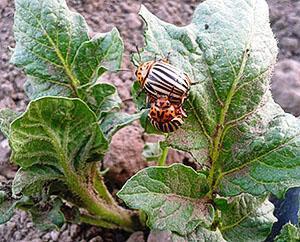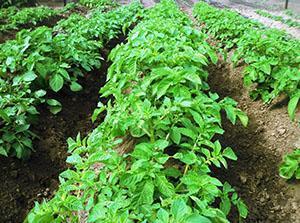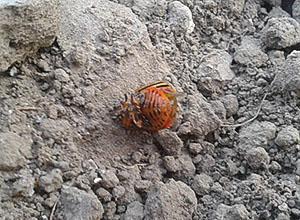Effective folk remedies for the Colorado potato beetle on potatoes
 The Colorado potato beetle is one of the most vicious opponents of every gardener. Growers process potato tubers and plants various chemicals several times throughout the growing season, but they often fail to achieve the expected results. Insects continue to destroy plants, and the crop from frequent spraying accumulates many toxic substances. Therefore, many people prefer to use exclusively folk remedies to protect potatoes from insects.
The Colorado potato beetle is one of the most vicious opponents of every gardener. Growers process potato tubers and plants various chemicals several times throughout the growing season, but they often fail to achieve the expected results. Insects continue to destroy plants, and the crop from frequent spraying accumulates many toxic substances. Therefore, many people prefer to use exclusively folk remedies to protect potatoes from insects.
A set of preventive actions

Fresh or rotted walnut leaves scare off pests well. In the fall, they need to be scattered throughout the site, and then dug up the garden. Plowing the land on the eve of a cold snap will destroy a significant part of the insects that did not have time to deepen enough in preparation for wintering. Throughout the winter, it is necessary to evenly scatter on the garden bed wood ash, which has a detrimental effect on leaf beetles and enriches the soil with useful vitamins (phosphorus, potassium).
 In the spring, before sprouting, several pieces of raw potatoes or their peel should be put in glass jars (0.5-1 l). The vessels must be buried flush with the surface of the ground, evenly distributing them throughout the bed. Such traps should be checked periodically and pests trapped in them should be destroyed. You can lure and collect insects using this method even after harvesting.
In the spring, before sprouting, several pieces of raw potatoes or their peel should be put in glass jars (0.5-1 l). The vessels must be buried flush with the surface of the ground, evenly distributing them throughout the bed. Such traps should be checked periodically and pests trapped in them should be destroyed. You can lure and collect insects using this method even after harvesting.
During the growing season, you need to periodically inspect the tops, and promptly carry out manual assembly and destruction of pests. In addition to the pests themselves, their larvae must be removed. And if the beetles on the potato are visible well enough, then sometimes it is not easy to find the eggs. Insects usually debug them on the inside of the leaves.
Newborn cubs are much more dangerous than old individuals. They are able to destroy a large area of plants in just one day. Therefore, it is important to prevent their birth as much as possible.
Powder protection for potatoes
 This old folk remedy for the Colorado potato beetle, with frequent use, can have a completely positive result. Scattering of tops and row spacings received a second name - "dry wrestling", which includes the following methods:
This old folk remedy for the Colorado potato beetle, with frequent use, can have a completely positive result. Scattering of tops and row spacings received a second name - "dry wrestling", which includes the following methods:
- Dusting leaves with seeded wood ash at the rate of 10 kg per one hundred square meters. The most effective are pine and birch ash.
- When interacting with moisture, corn flour tends to increase in volume. Getting into the stomach of an insect, it begins to swell strongly, which causes its death.
- The smell of fresh pine or birch sawdust scattered in the aisles is a good deterrent to leaf beetles.
It is recommended to sprinkle tops in the early morning on leaves moistened with dew or immediately after rain. Many summer residents, in search of new solutions, use cement and gypsum plaster to protect potatoes.
It is not the quantity of materials used that matters, but the frequency of the procedure!
Spraying potatoes with infusions and decoctions
 There is a wide variety of solutions for the preparation of which natural raw materials are used. Processing potatoes from the Colorado potato beetle with such infusions will help significantly reduce its livestock in the garden.
There is a wide variety of solutions for the preparation of which natural raw materials are used. Processing potatoes from the Colorado potato beetle with such infusions will help significantly reduce its livestock in the garden.
| Raw materials | The required amount for 10 liters of water. | Cooking method | Note |
| Walnut leaves | 1 kg | Pour boiling water over, leave under the lid for a week | |
| Acacia bark | 1 kg | Dry and grind, leave in a cool place for 3-4 days. | |
| Onion peel | 300 g | Pour in hot water, leave under pressure for a day | |
| Dandelion and horsetail herb | 200 g of each component | Boil for 15 minutes, the product is usable immediately after cooling | Use the finished broth at a concentration of 0.5 l per 10 l of water |
| Wormwood | 300 g | Mix with one glass of wood ash, add hot water, leave for three hours | |
| Garlic | 200 g | Thoroughly chop the bulbs and arrows, add warm water and leave for a day. | Ripe, but not shriveled leaves are suitable |
| Hemp | 600 g | Boil for 10 minutes, the cooled solution is ready for use | Use the leaves of a flowering plant |
| Tobacco | 0.5KG | Insist for two days | Dry roots, stems, or tobacco powder are suitable. The extract is diluted in a 1: 2 ratio |
| Bitter pepper | 100 g | Boil for 2 hours, apply immediately after cooling | |
| Celandine | 500 - 1000 g | Boil freshly cut leaves and stems for 10 minutes | The prepared solution is used at a concentration of 1:20 |
How and what to spray potatoes with is a purely personal matter of each grower. Many gardeners add sunflower oil, vinegar, mustard, and other specific ingredients to their solutions. Regardless of the composition, there are a number of rules and recommendations for the processing of garden crops with liquid preparations:
- Any of the solutions must be filtered before use to avoid clogging the spray nozzle.
- Spraying should be carried out in calm weather in the early morning or evening (from exposure to sunlight, the preparations quickly lose their insecticidal properties).
- Adding soap or washing powder to the solution improves its adhesion to the leaf surface.
- Despite the natural origin of the components of the agent used, it is necessary to work with it observing all safety measures.
Very effective for the treatment of potatoes from Colorado potato beetles is considered to be a tool created on their own basis. About half a liter jar of insects should be placed in 10 liters of water, covered with a lid. After 5-7 days, the solution will be saturated with the necessary toxins, and the "rodents" will settle to the bottom of the vessel. A liter of this insecticide is diluted with two liters of water.
Spraying undiluted potatoes can burn the tops!
Neighbors that "striped" does not tolerate
 Colorado beetles have well-developed sniffing receptors, so they do not like to live in areas where pungent odors prevail. To create such conditions in their garden, some vegetable growers alternate potato rows with plantings of other crops. Among the most "unloved" by the pest is onion, garlic, beans and beans. Some plants only give off a strong aroma when they bloom. It is customary for them to plant potato plantations around the perimeter. Calendula, coriander, violet and hemp have good deterrent properties. True, the cultivation of the latter is prohibited by law.
Colorado beetles have well-developed sniffing receptors, so they do not like to live in areas where pungent odors prevail. To create such conditions in their garden, some vegetable growers alternate potato rows with plantings of other crops. Among the most "unloved" by the pest is onion, garlic, beans and beans. Some plants only give off a strong aroma when they bloom. It is customary for them to plant potato plantations around the perimeter. Calendula, coriander, violet and hemp have good deterrent properties. True, the cultivation of the latter is prohibited by law.
Features of pest control
 Colorado leaf beetles are very thermophilic, preferring to lay their larvae in well-lit and sun-warmed areas. It has been noticed that in shady places the tops are eaten by insects much less. The pest also applies ambiguously to different varieties of potatoes. First of all, beetles eat bushes of early crops, the leaves and stems of which are usually not strong enough.
Colorado leaf beetles are very thermophilic, preferring to lay their larvae in well-lit and sun-warmed areas. It has been noticed that in shady places the tops are eaten by insects much less. The pest also applies ambiguously to different varieties of potatoes. First of all, beetles eat bushes of early crops, the leaves and stems of which are usually not strong enough.
In order to get rid of beetles on potatoes, it is advisable to use several methods overnight.The pest has the ability to adapt to certain drugs and conditions, so one cannot be limited to one specific method, no matter how effective it would be.
The fight will be much more effective if you destroy insects not only in your area, but also in the largest radius from it. Therefore, in such matters it is important to interact with the owners of neighboring plots, share knowledge and experience, look for common solutions on how to get rid of beetles on potatoes, and carry out all "anti-Colorado" operations in the same time frame.
The better to scare off the beetle is to destroy it
A reliable remedy for the Colorado potato beetle SOFIRY TOBACCO. The beetle prefers it to all other plants, eats and dies (scented tobacco is poisonous for him). If scented tobacco is sown in March, then by the time the beetle flies, the plants will gain strength and the beetle will no longer be able to devour them at any number. Plant scented tobacco around the edges of your potato plantings and you'll forget what the Colorado potato beetle looks like. The complexity of this method is lower than any other. Try it !!!
The beetle must not be scared away, but destroyed. We have not had him on the beds for more than 8 years and, I hope, will not ...
The devil is not so terrible as he is painted!
Once upon a time, ten years ago (or even more), my wife and I were so tormented by the Colorado potato beetle that we stopped planting potatoes, and I began to figure out what kind of "beast" it was and how to deal with it. Internet searches have shown that all the recipes boil down to either scaring the beetle away or destroying it physically or chemically. Finally, I managed to stumble upon an article by a biologist (unfortunately, I do not remember his name), which said that the favorite food of the Colorado potato beetle is scented tobacco plants, which are poisonous to him. It seemed interesting, and I began to treat all Moscow traders with seeds with the question: "Why is there no fragrant tobacco?" Two years later, scented tobacco went on sale. Unfortunately, these were seeds of the Dutch selection - multi-colored, but with a faint smell. We raised seedlings and planted them at the same time as planting the pot. The result exceeded all expectations. Since then, we have forgotten about the Colorado potato beetle. More than 8 years of life without the Colorado potato beetle and the feedback from those who followed our example allow us to try to give advice on the use of scented tobacco. First of all, be patient, as the whole process will take about three years. The land does not like vanity.
Now, in order:
1. It is necessary to sow fragrant tobacco on seedlings one and a half to two months before planting potatoes, so that by the time of planting in the ground, it has time to gain a height of 15 - 25 cm. Sowing it into the ground simultaneously with planting potatoes leads to the fact that the seedlings are completely eaten - the first bugs and nothing remains on the rest (from the reviews). Our only self-sowing plant of fragrant tobacco appeared only in 2015, and in 2016 there is already quite a lot. I think that it was the neighbor beetles who destroyed young tender sprouts in the first place.
2. The onslaught of the Colorado potato beetle on the closest neighbors has significantly decreased over the years (and our areas are 24x37 meters), so I believe that the radius of the protection zone of one plant exceeds 10 meters, but this is not the first year when your fragrant tobacco all the nearest beetles will go.
3. Be mentally prepared for the following:
a) beetles from all over the area will gather on your fragrant tobacco (let them eat and dough);
b) the larva of the Colorado potato beetle, which overwintered in the ground, is not very attractive with fragrant tobacco. For the first three years you will have to fight it yourself. The main thing is that new eggs will not be laid (according to one of the reviews, only larvae sat on the potatoes, and all the beetles gathered around fragrant tobacco).
In the first year, I advise to surround the potato plot with a "hedge" of fragrant tobacco in increments of 1 - 2 meters. Decide what to do next year based on local conditions. If you are late with the recommended planting dates for scented tobacco, you can plant it for the first time and later, just the first beetles will have time to lay eggs, but the effect will still be there next year. In the case of an extremely large number of beetles, when he can eat all the fragrant tobacco, you must be ready to plant a new batch.
The advantage of my method is very low labor intensity: "I planted and forgot". The beetle comes to the poison itself and eats it until it dies. The habit of the beetle to scented tobacco, in my opinion, is impossible. Starting from the third year, according to the calculation, 36 plants are sufficient to protect a square field of 1 hectare, 20 along the perimeter and 16 in potato rows with a step of 20 meters. The fragrant tobacco plant is unpretentious and should withstand hilling, however, this must be checked. The only difficulty is the first 1 - 2 years, when bugs from all over the area will collect on your scented tobacco. This must be experienced!
In conclusion, I will once again advise you to fight the Colorado potato beetle with fragrant tobacco, because this method is the best in terms of labor intensity, does not require the use of any chemicals and is completely harmless to all other living creatures that live in our gardens.
Let me question your comments about tobacco. The tobacco may kill the beetle, but the planting dates are somehow strange - March. In Nicaragua, you can probably plant in January, and in Russia, by mid-May, the snow has not melted everywhere, not to mention the fact that the earth would warm up. And the grass around the garden begins to grow almost at the same time as the potatoes. So even if tobacco is a perennial plant, it will still appear not much earlier than potatoes.